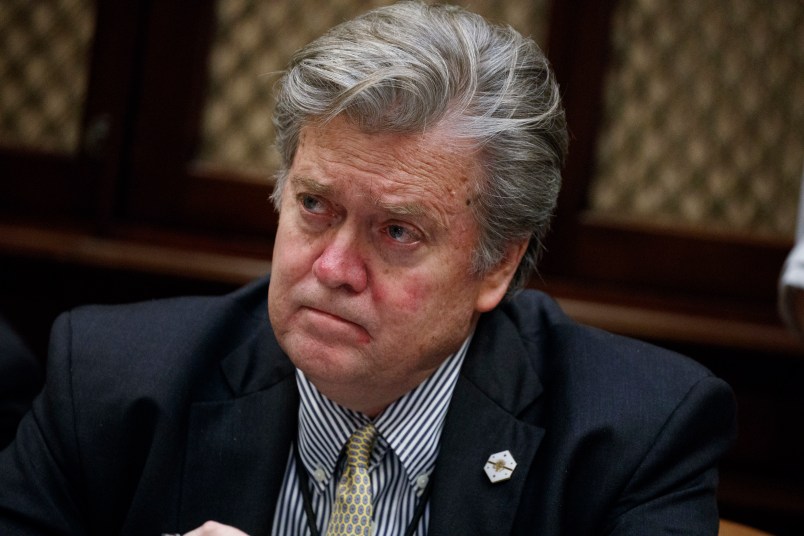Chief White House Strategist Steve Bannon has been removed from his position on the National Security Council, Bloomberg reported Wednesday.
Bannon’s position, assistant to the president and White House chief strategist, was not listed among the officials on the NSC’s Principals Committee in a Tuesday memorandum.
President Donald Trump had appointed Bannon to the Principals Committee shortly after he took office in January, drawing sharp criticism from lawmakers and foreign policy observers who feared that having a White House operative on the council risked politicizing national security decisions.
“He’s not a national security expert,” Julie Smith, deputy national security adviser to former Vice President Joe Biden, told TPM in March. “Other than having served in the navy for a little while in the late ‘70s and early ‘80s, he really doesn’t have any exposure to national security challenges whatsoever.”
Under the new memorandum, National Security Adviser H.R. McMaster was given latitude to set the agenda for NSC meetings.
The emerging White House line on Bannon’s demotion is that he was appointed to the NSC specifically to keep tabs on Michael Flynn, who was ousted as national security adviser in February. MSNBC’s Kristen Welker reported, citing anonymous sources, Bannon’s oversight role was no longer needed after Flynn’s removal.
“Susan Rice operationalized the NSC during the last administration,” Bannon said in a statement obtained by the Wall Street Journal. “I was put on to ensure that it was de-operationalized. General McMaster has returned the NSC to its proper function.”
Despite that oversight role, an administration official told the Journal that Bannon only attended one NSC meeting.
Previously, Bannon reportedly overruled McMaster on key personnel decisions. After McMaster allegedly attempted to remove Ezra Cohen-Watnick as senior director for intelligence programs, Bannon and White House adviser Jared Kushner were said to successfully petition Trump to keep Cohen-Watnick in that role.
Cohen-Watnick was later reported to be one of the sources helping funnel classified intelligence reports to House Intelligence Committee Chairman Devin Nunes (R-CA) that purportedly showed President Donald Trump and his transition officials were incidentally caught up in surveillance of foreign nationals.
The news of the NSC shakeup follows on the heels of a Tuesday night report from The Hill claiming that Bannon’s Strategic Initiatives Group, initially described as his “internal White House think tank,” never really had any teeth.
The SIG was set up in late January as an internal policy shop focused on long-term strategy, staffed by deputy assistant to the president Sebastian Gorka and Kushner, among others. Bannon’s dual role running the SIG and sitting on the Principals Committee sparked fears that he would circumvent the latter body and create a “shadow NSC” on foreign policy.
The anonymous White House officials who spoke to The Hill, however, downplayed the group’s importance and said it did not accomplish much. Those White House officials said SIG had been superseded by the Office of American Innovation, a recently announced government modernization effort headed up by Kushner.
“I’ve never known [SIG] to exist,” one unnamed White House aide told The Hill. “There was a lot of speculation about this early, but it was never officially rolled out and if anything, the OAI is an evolution and realization of some of these initial ideas.”
Bannon’s removal from the NSC and the reported dissipation of the SIG should come as a relief to national security experts who hoped McMaster’s arrival would bring some order to the Trump administration’s foreign policy shop.
Derek Chollet, the NSC’s senior director for strategic planning during the Obama administration, told TPM in March that the existence of these overlapping groups begged the question of “who speaks for the President on foreign policy.”
“This is a problem sort of intrinsic to Trump,” he said. “Foreign officials are puzzling over who they listen to—Jim Mattis, Rex Tillerson, whenever he rarely speaks, Steve Bannon, Sebastian Gorka. They’re desperately trying to figure out who’s who in the zoo.”
This post has been updated.







Un-fucking-believable!
Next step for Darth Bannon? Perp walk…
And another dead Russian, too.
Drip, drip, drip.
As I said on my own forum, who the hell put Sanity Powder in Dumblefuck’s coffee this morning?!?!?
Nice scoop, Allegra!